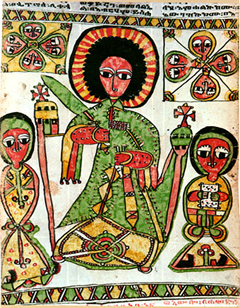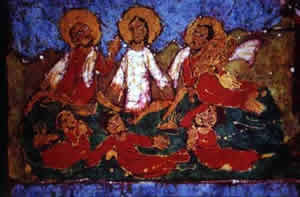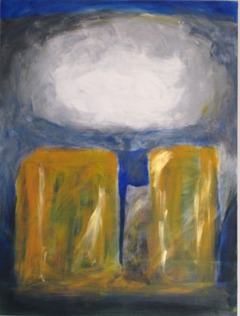From Our Archives
For other essays on this week's texts, see Amy Frykholm, Illuminating the Ordinary (2011); Dan Clendenin, The Majestic Glory (2017); and Debie Thomas, Is It Good for Us to Be Here? (2020).
This Week's Essay
For Sunday February 19, 2023
Lectionary Readings (Revised Common Lectionary, Year A)
Exodus 24:12–18
Psalm 2 or 99
2 Peter 1:16–21
Matthew 17:1–9
This Sunday February 19 is the last week in the short season of Epiphany. The following week we begin forty days of Lent on Ash Wednesday, February 22.
The Greek word for "epiphany" means disclosure, manifestation, unveiling or appearance. Matthew 17 for this week describes one of the greatest "epiphanies" ever — the Transfiguration of Jesus before Peter, James, and John, complete with blinding light, a heavenly voice, and visions of Moses and Elijah. The event was so mind-boggling that the epistle this week in 2 Peter 1 admits that some people dismissed the story as a “cleverly invented tale.”
And just as with another startling “disclosure” — Peter's confession of Jesus as the Messiah just one page earlier, it’s very strange that the Transfiguration concludes in all three synoptic gospels with a strict command of secrecy. "Don't tell anyone what you have seen," Jesus told his disciples.
But what's the purpose of an epiphany if you are told to keep it a secret?
A secret is hard to keep, especially one as terrifying as the Transfiguration, and the disciples didn’t keep that secret for long. In fact, the "transfiguration" (Greek, metamorphosis) of Jesus became so central to the gospel tradition that all three synoptic writers include it (Matthew 17:1–8 = Mark 9:2–10 = Luke 9:28–36). And so, on down to our own day, this week we observe “Transfiguration Sunday.”
Back in 1901, the German Lutheran scholar Georg Friedrich Eduard William Wrede published a book called The Messianic Secret. Wrede explored a motif that's present in all four gospels, and that’s conspicuously prominent in Mark. The provocative title of his book stuck in the minds of readers, and ever since then the phrase "messianic secret" has been a sort of shorthand for a perplexing phenomenon in the gospels.
 |
|
Ethiopian depiction of the Transfiguration.
|
Depending on how you count them, about 15 different times in the gospels Jesus explicitly suppresses knowledge about his identity. He wants to keep it a secret. There are at least 13 occurrences of this in Mark alone. Jesus conceals knowledge about himself in several different ways.
Sometimes he silenced the evil spirits that he exorcised: "he would not let the demons speak because they knew who he was."
He ordered his own disciples to keep silent after the two biggest “epiphanies” of all — after Peter's confession of Christ as the Messiah, and after the Transfiguration. Don’t tell anyone what you have seen and heard!
Jesus also told some of the people that he had healed to keep quiet. After he healed the leper in Mark 1, "Jesus sent him away with a strong warning: 'See to it that you don't tell this to anyone.'" But human nature being what it is, the temptation was too much, and the man ignored Jesus’ command: “he went out and freely proclaimed it and spread the news” everywhere.
In private discussions away from the crowds, Jesus told his disciples that he "explained everything" about the "secret of the kingdom" to them, whereas those on the "outside" got only obfuscating parables. And those parables, we read in another place, not only revealed truth; sometimes they obscured and hid the secrets of the kingdom, which is precisely why Jesus told them.
When he traveled, sometimes Jesus "did not want anyone to know where they were." In John 7, for example, he went to the Feast of Tabernacles "in secret" in order to hide his identity. This was right after his own brothers urged him to do the opposite: “no one does anything in secret” when they want to get their message out there; “show yourself to the world!” Similarly, the gospels describe how Jesus would often withdraw by himself "to a lonely place."
In the beatitudes of Matthew 6, Jesus taught us to give, to pray, and to fast, all "in secret." God the Father, he says, will "see what is done in secret." Piety done publicly incurred his judgment.
There are also broader corollaries to these specific examples. Until he burst onto the public scene for three years of ministry, Jesus lived for thirty years in total obscurity — he led a hidden life about which we know nothing at all. I like to think that his life was so ordinary and uneventful that nobody remembered anything about it.
Paul told the Corinthians, the Ephesians, and the Colossians that the gospel was a secret or mystery that had been revealed. But not everyone understood the secret. In 1 Corinthians, Paul contrasts “the wisdom of this age” with “God’s wisdom in a mystery that is hidden,” and decidedly “not of this age.” Consequently, “none of the rulers of this age” understood the gospel mystery.
 |
|
The Transfiguration, batiq by Solomon Raj, India.
|
The earliest Christians who worshipped in the catacombs of Rome were criticized by pagans for their secret meetings and bizarre rituals, rumored to include cannibalism, incest, and infanticide. They were people who lived on the periphery of mainstream culture — antisocial, avoiding the theater and the games, and apolitical, refusing to run for office. The Christians, griped the critic Caecilius, "do not understand their civic duty."
There was at least some justification for these charges of secrecy — early baptismal instruction lasted many months, during which time the full gospel was deliberately kept secret from the baptismal candidates.
Why all this secrecy? What does it mean in its original context, and for us today in our culture of internet “influencers?”
Ever since Wrede, scholars have debated every aspect of the "secrecy motif." Some people even dismiss it altogether, as an over-reading, or as much ado about nothing.
Secrecy might have been a political strategy by Jesus to avoid unwanted attention from the Roman authorities. No doubt sometimes there was the practical element of crowd control. There's also a sense that he was "biding his time" and that he didn't want any premature ending to his mission. But none of these rationales fully explain why secrecy is such a prominent literary theme in Mark.
A few years ago I read a book by Jonathan Malesic called Secret Faith in the Public Square; An Argument for the Concealment of Christian Identity (2009). The title sounds crazy (which is one reason I liked it), until you consider the breadth and depth of the secrecy motif in the gospels.
Malesic commends a simple theme from Scripture: "Beware of practicing your piety before others in order to be seen by them. . . But whenever you pray, go into your room and shut the door and pray to your Father who is in secret; and your Father who sees in secret will reward you" (Matthew 6:1, 6).
He laments the enormous damage done to the faith by its putative "success" in society. For many American believers, faith is a form of currency (political, economic, social) by which they accrue personal benefits. Think of a politician who makes sure that voters know that he attends church.
 |
|
The Transfiguration by Mimi Ess.
|
Malesic's response to this problem is counter intuitive. He tries to show how intentional secrecy about one's faith "is a real though under emphasized theme in Christian theological, liturgical, and spiritual tradition." To save our faith we must veil it from others.
He has in mind Christianity in America, and especially the "bourgeoisie" and "cosmopolitan evangelicals" who enjoy and strive for social privileges by wearing faith on their sleeves. Only by a return to secrecy, by which Malesic means "intentional concealment of knowledge from another person," can American Christianity be saved from its opportunistic impulse to exploit the gospel for social gain.
Malesic devotes two chapters each to three Christians who exemplify Christian secrecy. Cyril of Jerusalem's catechetical practices withheld knowledge of the sacraments until after baptism. Kierkegaard's book Works of Love argues that genuinely selfless acts must be hidden in order to avoid the quid pro quo of praise. He was also (in)famous for his pseudonymous authorship and “indirect” communication. Third, Dietrich Bonhoeffer wrote that "the Christian cause will be a silent and hidden affair."
So, says Malesic, concealing one's Christian identity is "not an isolated tradition." His book reminded me of the poem by Emily Dickinson (1830–1886) called Tell it Slant:
Tell all the Truth but tell it slant —
Success in Circuit lies;
Too bright for mind's infirm intent,
The Truth's superb surprise.
As Lightning to the Children eased,
With explanation kind;
The Truth must dazzle gradually,
Or every man be blind.
When I mentioned Malesic's book to a prominent church leader who speaks all around the country, he scoffed. I should have known better. But in our world of Total Information and Hype, in our culture of over exposure, I think Malesic might be on to something.
Footnote: For the 13 references to secrecy in Mark: 1:21–28, 29–34, 40–45;3:7–12; 4:10–12, 33–34; 5:21–43; 7:31–37; 8:22–26, 27–30; 9:2–13, 30–32; and 13:3–4.
Weekly Prayer
Boris Pasternak (1890–1960)
To Be Famous
Creation calls for self-surrender,
Not loud noise and cheap success.
Life must be lived without false face,
Lived so that in the final count
We draw unto ourselves love from space.
So plunge yourself into obscurity
And conceal there your tracks.
But be alive, alive your full share,
Alive until the end.
Dan Clendenin: dan@journeywithjesus.net
Image credits: (1) Matt Stone; (2) AsianChristianArt.org; and (3) MimiEss.com.





